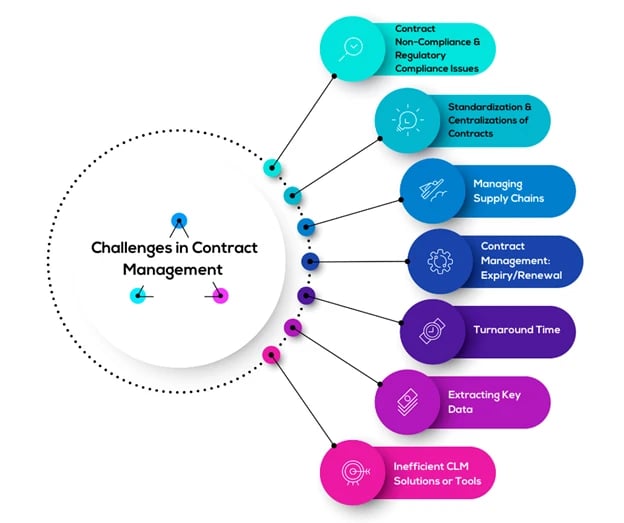
Manual Contract Management vs. Electronic Contract Management
If your company still uses traditional manual contract management, you are putting yourself at a massive competitive disadvantage and will most likely not have the same level of productivity and results as organizations that utilize electronic contract management processes.
While technology has evolved and revolutionized businesses and industries on a global scale, technology and artificial intelligence have played a major role in how contract management has changed today. Every business wants to find ways to save time and resources so they can spend more of their efforts on tasks that demand more manual attention and labor. Through various digitized and electronic contract management features that are currently available, businesses can automate processes and make contract management incredibly simple and far more results driven.
Your company’s contract management performance is dependent on the level of speed and accuracy at which your contract management system operates. Several contract processes including the building, negotiation, and execution of contracts are largely impacted by how quickly your organization is able to complete contract-related transactions with third parties. A faster contract management process will increase the speed of individual contract lifecycles, resulting in efficient and faster sales.
In a manual contract management system, processes are often disorganized and delayed due to back-and-forth email communication, utilization of spreadsheets for data tracking, and the employment of shared drives for document storage. It’s inevitable for one of these methods to falter and fail at some point or another. They’re simply slower than an automated and electronic form of managing contracts. Stay ahead of the competition by using an electronic contract management system so you can drive growth and close deals efficiently.
Electronic contract management offers numerous benefits when compared to its manual counterpart. For example, cloud-based centralized contract repositories have changed the game in contract management. Storing, sorting through, organizing, managing, and searching for contracts is seamless with the help of a centralized repository. Your repository is equipped with filtered search functions, customizable notifications, and permissions-based access controls so that you can keep your organization protected. With the example of a repository, you reduce time spent searching for physical copies of documents or contracts in filing cabinets, and you can easily track and find specific deadlines and documents within the software. That’s just one pertinent example, but an electronic contract management system can improve your organization’s contract processes wholesale by automating several processes and mitigating risk. In this way, you effectively work towards producing a higher return on your investment.
Where Manual Contract Management Goes Wrong
Does your company consistently oversee and manage a large volume of contracts?
Are the contracts highly complex and require a lot of individual attention?
Managing contracts with a manual method can bring several negative consequences and set your business back substantially. It’s important that your business evolves with technology and uses the modern tools available to maintain competitiveness. For the best possible results, it’s necessary to manage contracts and other related legal documents within an electronic contract management software system.
Managing documents manually can be very risky, no matter the size of the organization. Electronic contract management also offers increased security that can reduce legal risks. To ensure compliance and optimal levels of productivity, transitioning to an electronic solution is the way to go. Additionally, when you manage contracts manually, you’re bound to run into bottlenecks and incur pointless delays that make it a lengthier process overall.
Why prolong the execution of a contract when there’s an option available that can help speed it up?

The 3 Pitfalls of Manual Contract Management
1. Missed Due Dates
With a high volume of contracts, it can be difficult to keep an organized tracking system of approaching due dates and deadlines pertaining to contract renewals, contract expiry dates, and more. In manual contract management, tracking these dates oftentimes occurs on spreadsheets. However, a spreadsheet can’t send an automated reminder.
Does your company miss contract due dates somewhat often?
Have you implemented an automated reminder and alert system to stay up to date?
Missing contract dates on a consistent basis can lead to soiled business relationships and the potential to renew contracts that aren’t favorable moving forward. You might incur detrimental financial impacts from the effects of missing important due dates.
With an electronic contract management system, your entire team can stay in the loop on every approaching due date. You can create customized notifications, reminders, and alerts within the system and assign such notifications to specific users and certain departments. In this way, your employees can plan ahead and get reminded of dates in a timely manner that makes working far more effective and communicative. Another great, and sometimes overlooked feature of a contract management system, is the calendar feature that allows you to filter specific items so you can have a detailed overview of what’s to come for your business’ contract management system.
2. Loss of Contracts and Documents
Manual contract management is inherently risk-prone due to the massive quantity to physical contracts and documents that are handled, filed, and sent. Take this into consideration – if your company loses a single contract, how can you be sure that your company is fully in compliance with the terms within the missing contract?
If your company has a disorganized contract management system that requires a lot of time and effort in locating specific documents in physical storage files, emails, or desktops, then it’s time to find a solution to the problem of disjointed and outdated contract management. An electronic contract management system helps securely store all of your organization’s contract and documents in a single location. With the assistance of a centralized contract repository, you can confidently store documents and prevent against unnecessary data loss.
Your documents will be kept confidential and protected with the repository, and data will be backed up and supported by the cloud environment. In addition, your contract repository guards against cyber security threats and access from unauthorized parties. Your centralized contract repository increases visibility and accessibility within your organization by providing your employees a simplistic way to access and store contracts.
3. Lengthy Contract Lifecycles
A manual contract management process almost always results in longer contract lifecycles than the lifecycles of contracts overseen by an electronic contract management system. Contract creation, negotiations, and contract execution is extraordinarily faster when an electronic contract management system platform is used. With the number of parties and teams involved in the lifecycle of a single contract, contract reviews and communication processes can take a very long time. Additionally, in a manual contract management system, locating documents on shared drives can take additional time and potentially lead to document misplacement and mistakes due to access to multiple drafts that are improperly labeled.
Reducing the duration of a contract lifecycle is the goal for more efficient and productive contract management. We highly recommend utilizing an electronic contract management system to shorten contract lifecycles and to improve your contracting processes. Centralizing contract management and reviews rather than communicating via back-and-forth emails can help reduce the time it takes to execute contracts. To add, electronic contract management systems contain specialized search functions that help your contract management team locate exact documents and clauses quickly. Electronic contract management systems are also a standout because they possess audit trails, redlining capabilities, and version tracking controls to help reduce discrepancies.
In general, contract management can be an incredibly costly business operation that the majority of companies have to oversee. Contract management requires hundreds upon thousands of hours of time spent distributed across your organization’s departments. The success of a single contract can mean major financial gains for your organization. So, it’s clear that implementing the best possible, most competitive, and optimized contract management software solution is the way to go to give your company the edge it needs to grow and to succeed.
If you choose to stay with a manual contract management system, contracting will cost far more than it has to. By using a disjointed contract storage method, you will inevitably waste thousands of hours of employees working time on a yearly basis. You also increase risk exponentially. When considering the long-term implications of a manual contract management system, the result is subpar at best. Suboptimal and disjointed contract lifecycle management means missed deadlines and payments, as well as low performing contracts. Implement an electronic contract management system today to protect against these major downfalls of a manual contract management system.
Conclusion
Here at Dock, we are experts in SharePoint and Office 365 and want to help business utilize their features to revolutionize and streamline contract management. Our Contract Management System is equipped with several amazing features that will help improve the quality of your contract management processes with the help of a SharePoint and Office 365-based collaborative software interface. Improve business dealings, increase contract compliance, reduce bottlenecks and turnaround times, enhance risk mitigation efforts, and completely overhaul contract management team productivity for the better with our contract management software.
Ready to get started today? Reach out to us to learn more about our Dock 365 Contract Management System.
Book a Live demo
Schedule a live demo of Dock 365's Contract Management Software instantly.

Written by Lindsey Paulk
Lindsey Paulk is a Content Writer in Jacksonville, Florida that specializes in digitally communicating all-things contract management.



